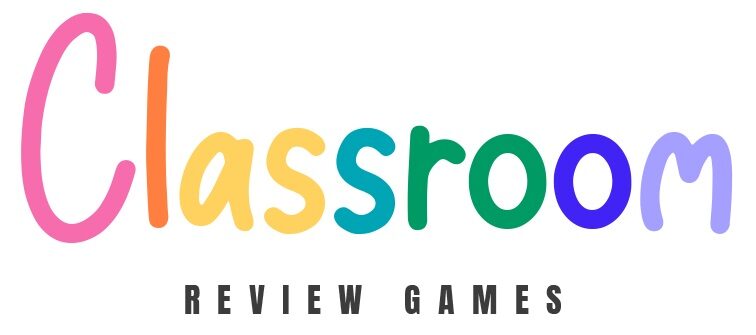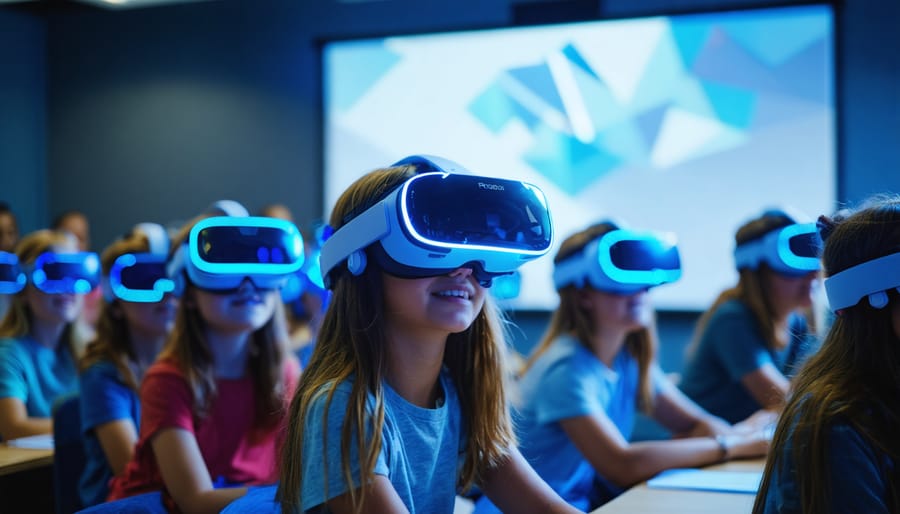VR Games Transform Classroom Reviews Into Immersive Learning Adventures
Transform your classroom into an immersive learning environment with virtual classroom games that engage students like never before. VR technology isn’t just changing how we teach—it’s revolutionizing how students learn, retain information, and develop critical thinking skills.
Imagine your students exploring ancient Rome, dissecting virtual organisms, or solving complex math problems in 3D space—all from the safety of your classroom. Studies show that VR-based learning can increase student engagement by up to 80% while improving information retention by 30% compared to traditional teaching methods.
For educators ready to embrace this technology, VR classroom games offer an unparalleled opportunity to create memorable, interactive lessons that cater to different learning styles. Whether you’re teaching history, science, mathematics, or language arts, VR provides a platform where abstract concepts become tangible experiences, making complex subjects more accessible and enjoyable for students of all abilities.
Why VR Games Are Revolutionizing Classroom Reviews
Enhanced Student Engagement
VR classroom games transform traditional learning into an adventure that captivates students from the moment they put on their headsets. Unlike conventional teaching methods, VR creates a 360-degree environment where students don’t just learn about topics – they experience them firsthand.
Imagine your students walking through ancient Rome, exploring the human circulatory system from inside a blood vessel, or conducting virtual chemistry experiments. This level of immersion naturally captures attention and makes learning feel more like discovery than studying.
The magic of VR lies in its ability to eliminate distractions. When students are fully immersed in a virtual environment, they’re less likely to be distracted by their phones or classmates. The interactive nature of VR games keeps them actively engaged, as they must participate and make decisions to progress through lessons.
Students also show increased emotional investment in their learning when using VR. Whether they’re solving puzzles in a virtual museum or collaborating with classmates in a shared virtual space, the hands-on experience creates memorable learning moments that stick with them long after the lesson ends.
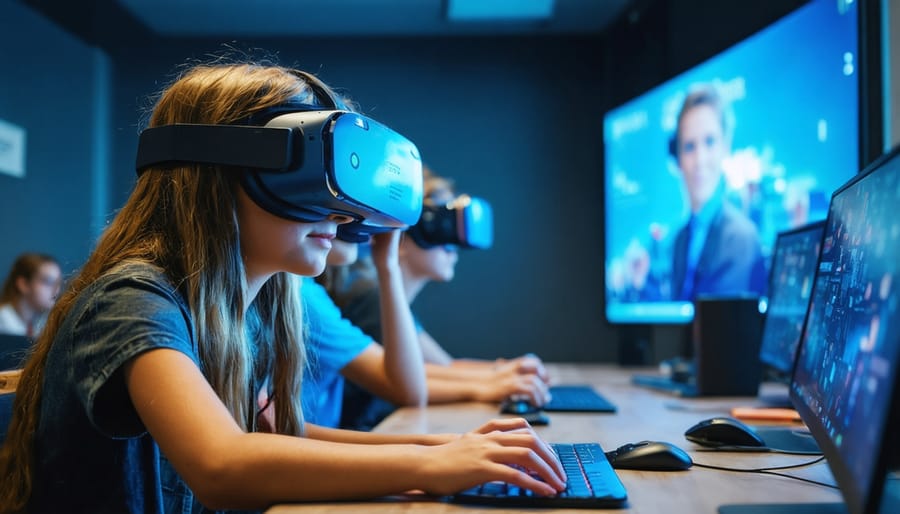
Multi-Sensory Learning Benefits
VR classroom games offer a remarkable advantage by engaging multiple senses simultaneously, making learning more effective and memorable. When students can see, hear, and interact with 3D content, they’re more likely to retain information compared to traditional learning methods.
Visual learners thrive as they explore detailed 3D models and immersive environments. Auditory learners benefit from spatial sound effects and verbal instructions that feel natural within the virtual space. Kinesthetic learners particularly excel as they use hand controllers to manipulate objects and perform virtual experiments.
This multi-sensory approach creates stronger neural connections, helping students form lasting memories. For example, when learning about the solar system, students can visually observe planet rotations, hear cosmic sounds, and physically navigate through space – creating a complete sensory experience that reinforces learning.
Teachers report that students show improved recall and understanding when concepts are presented through multiple sensory channels. The immersive nature of VR also helps maintain focus by blocking out external distractions, allowing students to fully engage with the learning material.
Popular VR Review Games for Your Classroom
Subject-Specific VR Games
Let’s explore some amazing VR games that can transform your subject teaching! Here’s a breakdown of engaging options across different academic areas:
For Mathematics, check out NumberSpace VR, where students can manipulate 3D shapes and solve equations in a space-themed environment. GeoGebra AR brings geometry to life, letting students walk through and interact with complex mathematical concepts.
Science teachers will love Discovery VR Lab, where students can conduct virtual experiments safely and explore complex molecular structures. For biology classes, The Body VR takes students on an incredible journey through the human body, making anatomy lessons unforgettable.
History comes alive with TimeLooper, allowing students to visit historical sites and witness key events firsthand. Ancient Civilizations VR lets classes explore reconstructed ancient cities and interact with period-accurate artifacts.
Language learning gets a boost with VirtualSpeech, where students practice conversations with AI-powered characters in realistic scenarios. For literature classes, Shakespeare VR transports students directly into famous plays, making classic texts more engaging.
Art teachers can utilize Tilt Brush to help students create stunning 3D masterpieces, while music classes benefit from Soundscape VR for understanding composition and rhythm.
These immersive experiences make learning more interactive and memorable, helping students grasp complex concepts through hands-on exploration. Mix and match these games to create dynamic lesson plans that keep your students engaged and excited to learn!
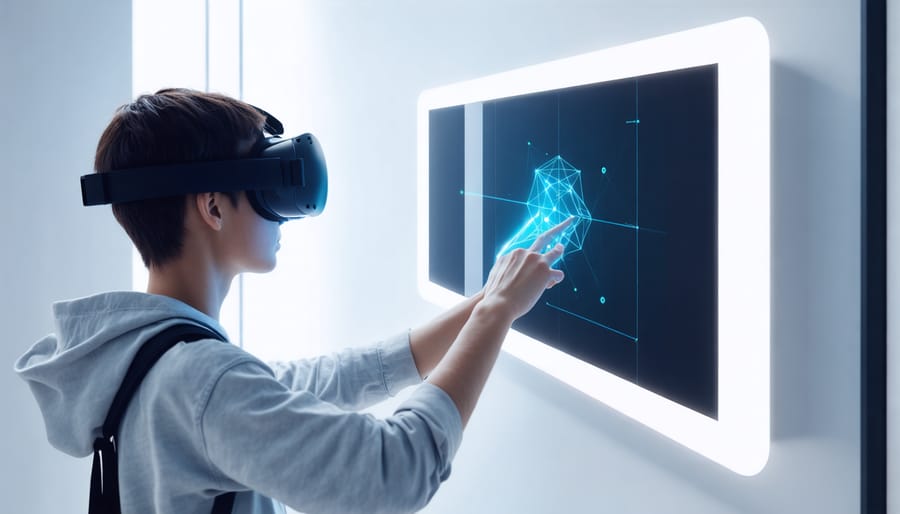
Collaborative VR Review Activities
Get your students excited about learning with collaborative VR review sessions that transform regular study time into engaging virtual adventures! These team-based review activities create an immersive environment where students can work together, solve problems, and reinforce their understanding of course materials.
Picture your class exploring a virtual museum together, with teams competing to identify historical artifacts, or working collaboratively in a virtual science lab to conduct experiments. Students can take turns being team leaders, explaining concepts to their peers while navigating through interactive 3D environments.
Popular collaborative VR review games include:
– Virtual Escape Rooms: Teams solve curriculum-based puzzles together
– Knowledge Quest: Groups explore themed worlds while answering review questions
– Virtual Lab Partners: Students pair up to complete virtual experiments
– World Builder: Teams create and present virtual learning environments
The best part? You can easily monitor student interactions and progress in real-time while they help each other learn. Watch as naturally shy students become more confident in the virtual space, and see how peer-to-peer teaching reinforces learning for both the explainer and the listener.
Remember to rotate team members regularly to ensure all students get to experience different roles and interact with various classmates. This approach not only makes review sessions more fun but also builds important collaboration and communication skills.
Implementation Tips for Teachers
Technical Setup Basics
Getting your VR classroom set up is easier than you might think! Start by clearing a safe play area – you’ll need about 6×6 feet of open space for students to move comfortably. Choose a spot away from windows to prevent glare on the headsets.
Next, set up your charging station. A simple power strip and dedicated shelf work great for keeping headsets ready to go. Make sure each headset is fully charged before class begins – most take about 2 hours to charge completely.
Create simple rules for your VR space: one student at a time in the play area, others must stay seated, and always have a spotter for safety. Put these rules on a visible poster near your VR station.
Consider having cleaning wipes handy for quick sanitization between users. Many teachers find that disposable VR face covers are helpful for shared equipment.
For smoother sessions, assign student helpers to manage equipment distribution and basic troubleshooting. They can help peers adjust straps and focus settings, saving you valuable class time.
Pro tip: Start with shorter 15-minute VR sessions until students get comfortable with the technology. This helps prevent motion sickness and keeps everyone excited about their turn!
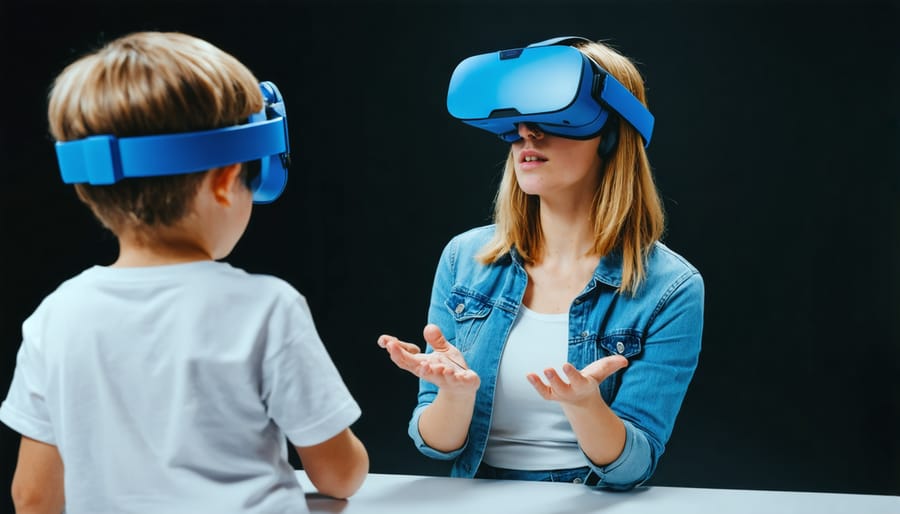
Classroom Management Strategies
Managing a VR review session doesn’t have to be challenging! Start by establishing clear ground rules before students put on their headsets. Create a simple hand signal system for when students need help or feel uncomfortable. Designate a specific area as the “VR zone” where students can move safely without bumping into furniture or each other.
Consider using a buddy system – while one student explores the VR environment, their partner can take notes or offer guidance. This not only enhances safety but also promotes collaborative learning. Set up a rotation schedule to ensure everyone gets equal VR time while keeping other students engaged with related activities.
Keep sessions short (15-20 minutes per student) to prevent motion sickness and maintain focus. Have a cool-down area where students can rest if they feel overwhelmed. Use a timer or gentle audio cue to help students track their time in VR.
Remember to monitor student behavior closely and be ready to intervene if needed. Keep your device management organized with a simple checkout system and cleaning routine between uses. Having clear procedures for putting on and removing headsets will help maintain equipment and keep your VR review sessions running smoothly.
Measuring Success with VR Review Games
Tracking the success of your VR review games helps ensure they’re making a real impact on student learning. Start by collecting baseline data through quick pre-game assessments to measure initial understanding. After students complete the VR review activities, use post-game quizzes to gauge improvement.
But don’t stop at traditional test scores! Monitor student engagement by observing their enthusiasm, participation levels, and time spent in the VR environment. Many VR educational platforms offer built-in analytics that track completion rates, accuracy, and time spent on different concepts – use these insights to identify areas where students might need extra support.
Consider implementing a simple rating system where students can provide feedback about their experience. Ask questions like: “How helpful was this review game?” or “What concepts became clearer after playing?” This direct feedback is invaluable for fine-tuning your VR activities.
Keep a digital portfolio of student progress over time, including screenshots or recordings of their VR sessions. This visual documentation helps demonstrate growth and can be particularly powerful during parent conferences.
Remember to celebrate improvements, no matter how small! Create a classroom leaderboard or reward system that acknowledges both academic progress and effort. This positive reinforcement encourages continued engagement with VR review activities while building confidence in the subject matter.
VR review games represent an exciting frontier in educational technology, offering a perfect blend of engagement and effective learning. By incorporating these immersive experiences into your classroom, you’ll transform routine review sessions into adventures that students eagerly anticipate. Remember that success lies in starting small, perhaps with one unit or subject area, and gradually expanding as you and your students become more comfortable with the technology. The investment in time and resources pays off through improved student participation, better retention of material, and the development of crucial digital literacy skills. As education continues to evolve, VR review games stand out as a powerful tool that makes learning both memorable and enjoyable. Take that first step today – your students will thank you for bringing their learning experience into the future!
